Butterflies with elegant projections extending from their hind wings are known as “swallowtails”; the swallowtails can be seen clearly below. However as a butterfly ages, the outer edges of its wings start to wear away. The thin, little swallowtails are usually the first to go. So you may find yourself looking at a swallowtail species without seeing any swallowtails at all. The “tiger” part of this butterfly’s name comes from the four black stripes that start at the outer, front edge of its wings
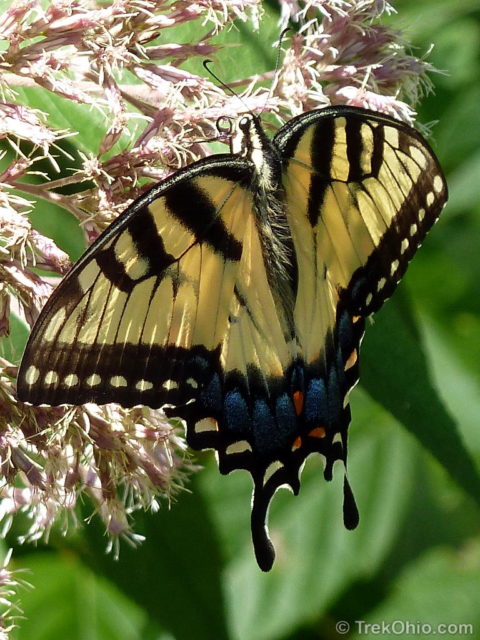
It’s easy to distinguish between the male and female butterflies belonging to the Eastern Tiger Swallowtail species. The above photo is a female representative of the species as viewed from the top. The underside of a female’s wings can be seen below.
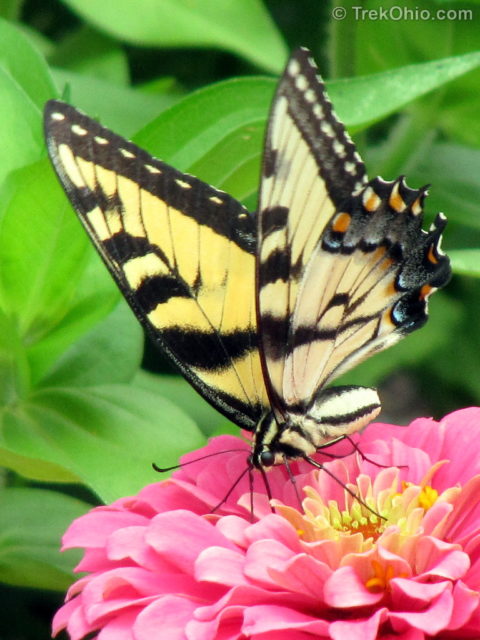
Now let’s look at some males.
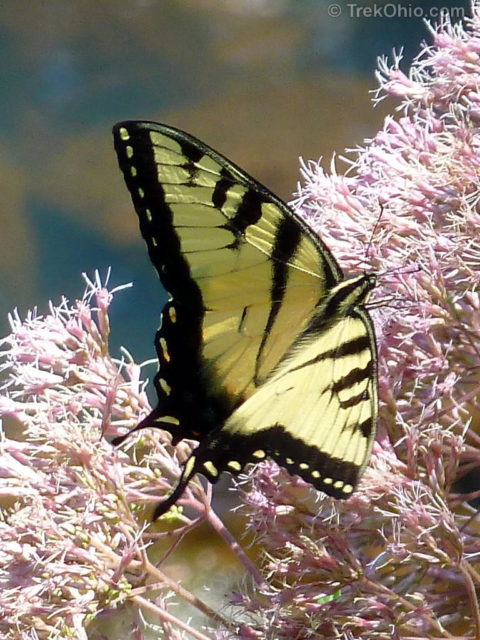
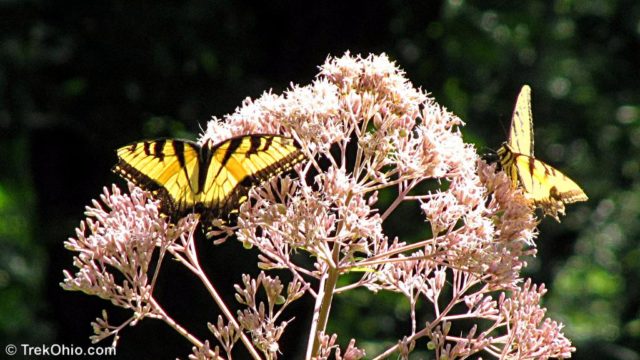
As beautiful as the male is, the female is the showier of the two. Her hind wings have a prominent band of blue with bright orange accents when viewed from the top. The areas that are blue on the female are black on the male, although its possible for the male to have some tiny flecks of blue. I’m told that the female is larger than the male, but I don’t think I’d ever pick up on that in the field.
Well, I’m glad we got that all straightened out… But wait! There’s more. It turns out the female Eastern Tiger Swallowtail may look nothing like the one shown at the top of this post. Yes, the following two photos of black butterflies are also female Easter Tiger Swallowtails.
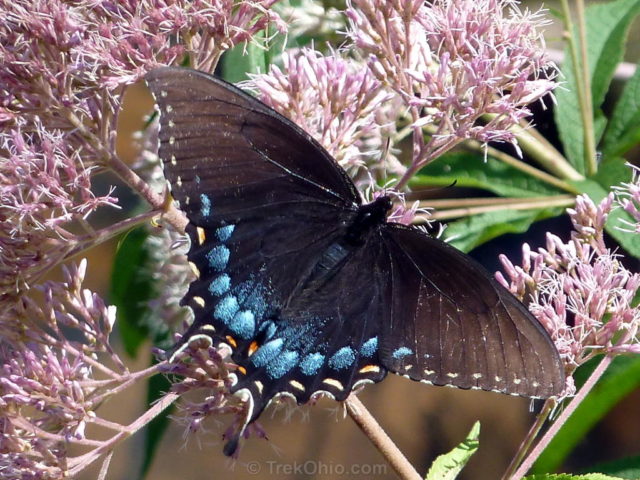
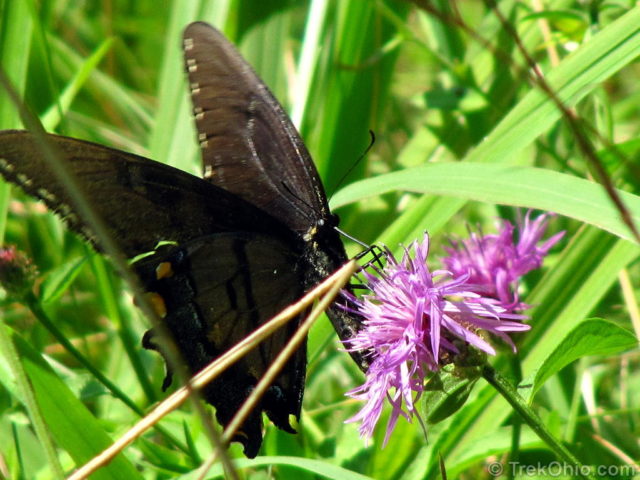
All the areas of the wing that were yellow before are black in these last two photos. Even the body that was yellow with longitudinal black stripes is now just black. Because the female has two, different looks, she is dimorphic, and the black version is called the dark morph.
Well, once I got that down I thought I was all set to identify Eastern Tiger Swallowtails in the field like the one below.
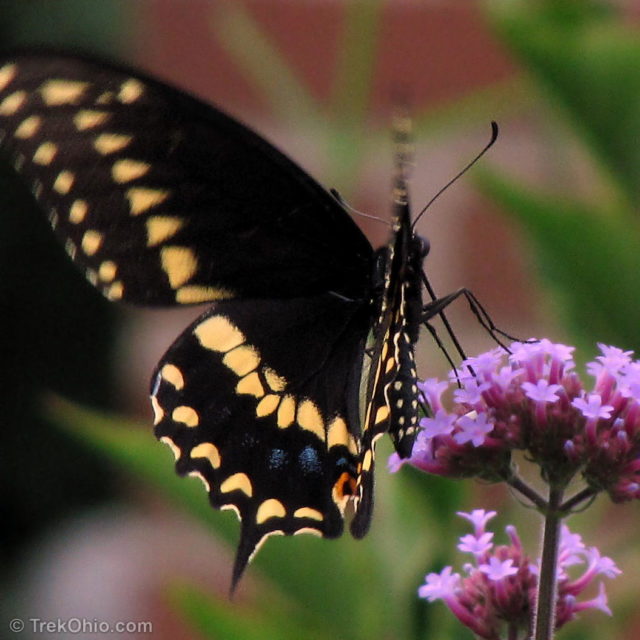
Hmm. I thought I had this down. The butterfly above is definitely a swallowtail, but I guess if I compare it to the dark morph, it has way too much yellow. The dark morph of the Eastern Tiger Swallowtail has a tiny row of light dots near the outer edge of its wings, but the butterfly above has two bands of large yellow dots accenting its outer wings. Plus the body also has yellow dots. That makes it a different species altogether; it’s a Black Swallowtail.
Okay, I think I have it now. If I see a black butterfly with blue on its hind wings and two rows of large, yellow dots around its wings’ edges, it’s a Black Swallowtail. But if it’s black with blue on its hind wings and just a row of tiny, light dots around the edge of its wing, then it’s a dark morph of the Eastern Tiger Swallowtail. So the next photo must be a dark morph whose swallowtails have worn off.
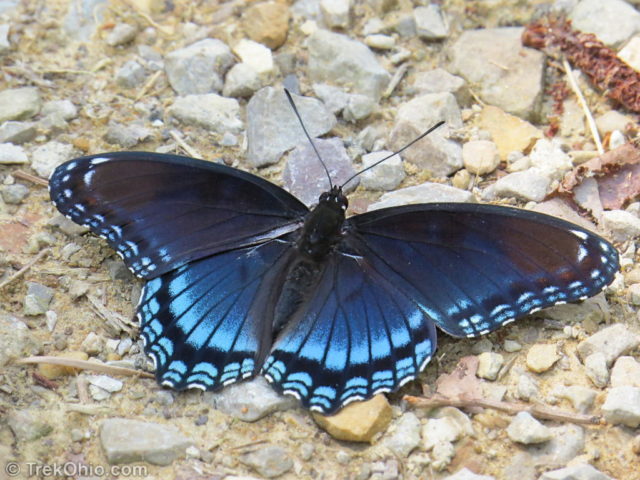
But wait! The dark areas of the front wings seem to have some red mixed in with them. So this can’t be an Eastern Tiger Swallowtail. ![]() The reddish spots make this a Red-spotted purple butterfly. It’s not a swallowtail at all. It’s actually easier to see the red spots on the underside of its wings.
The reddish spots make this a Red-spotted purple butterfly. It’s not a swallowtail at all. It’s actually easier to see the red spots on the underside of its wings.
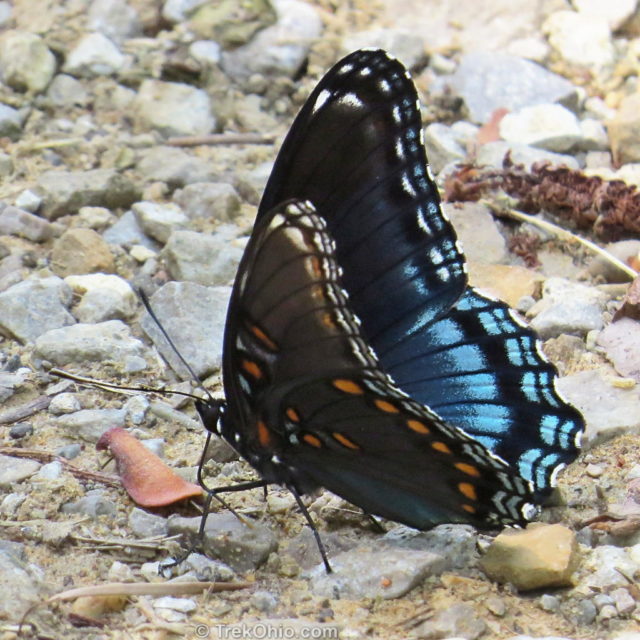
Well, I’m glad that I got that sorted out. So later I’m reading a bit more about the Eastern Tiger Swallowtail’s dark morph, when I learn that it has a certain survival advantage because it strongly resembles another black butterfly, the poisonous Pipevine Swallowtail… another black butterfly?
![]()
Okay, give me a moment to pull myself together… all right, I’m ready to push on. It turns out that I have never even seen a Pipevine Swallowtail, but after looking at the distribution map published on this page, it’s clear that it is all over Ohio. So I traipsed on over to Flickr to see what photos of Pipevine Swallowtails had been published under a Creative Commons license, and I came up with this one published by Anita Ritenour.
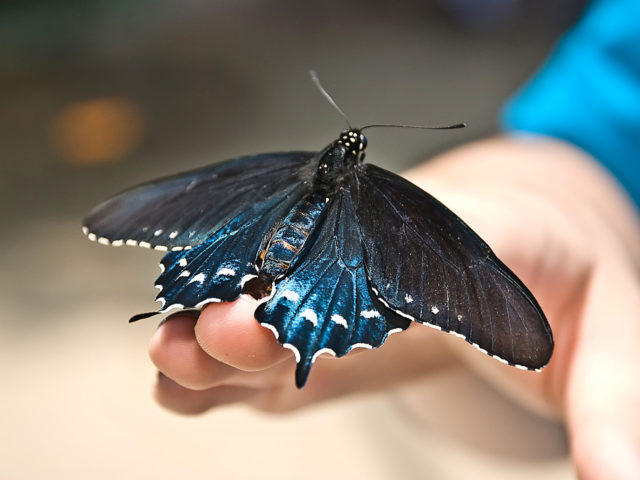
The Pipevine Swallowtail is poisonous to eat, not to the touch.
So this child is in no danger. ![]()
Okay, I can see why the resemblance would confuse a bird because it kind of confuses me. ![]() But if I look more closely, I notice these differences between the Pipevine Swallowtail and the dark morph of the Eastern Tiger Swallowtail. The Pipevine Swallowtail has prominent white spots running through the blue on its hind wings, and it has white spots on its head. The dark morph has neither.
But if I look more closely, I notice these differences between the Pipevine Swallowtail and the dark morph of the Eastern Tiger Swallowtail. The Pipevine Swallowtail has prominent white spots running through the blue on its hind wings, and it has white spots on its head. The dark morph has neither.
If you see it lift its wings, the difference between the two becomes even more pronounced because the Pipevine Swallowtail has large red spots on the underside of its wings and white spots on its body, while the dark morph does not. Here’s another photo from Flickr published under a Creative Commons license by Mike Baird.
I will leave it as an exercise for the reader to distinguish between the red spots on the underside of the Pipevine Swallowtail and those on the Red-spotted purple butterfly. And with that I conclude today’s lesson. ![]()
Update
Almost as soon as I published this, Karen of Karen’s Nature Art wrote in to point out that the Spicebush Swallowtail also resembles the dark morph of the Eastern Tiger Swallowtail, and that the two of them are trying to mimic the poisonous Pipevine Swallowtail. ![]() This sent me staggering over to Flickr to see what the Spicebush Swallowtail looks like. The photo below was published by BobIsTraveling under a Creative Commons License.
This sent me staggering over to Flickr to see what the Spicebush Swallowtail looks like. The photo below was published by BobIsTraveling under a Creative Commons License.
Below Barb Dunlap published a photo of a Spicebush Swallowtail that shows the underside of its wings.
And while I was looking around, I discovered that the caterpillar of the Spicebush Swallowtail has the cutest, fake face ever. Check it out below.
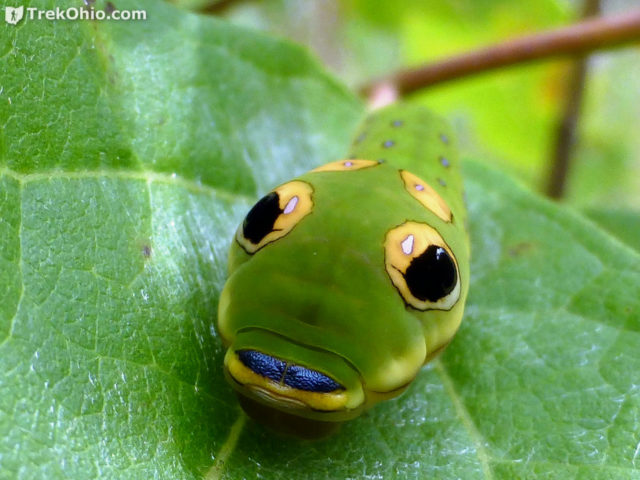
Additional information
- Papilio glaucus (Latin name for “Eastern Tiger Swallowtail Butterfly”), published at Wikipedia
- Batesian mimicry (pretending to be a species that a predator would want to avoid), published at Wikipedia
- Battus philenor (Pipevine butterfly – a poisonous butterfly that looks similar to the dark morph of the Eastern Swallowtail Butterfly), published by Wikipedia.
- Limenitis arthemis astyanax (Latin name for the “Red-spotted Purple Butterfly”), published at Wikipedia
- Papilio polyxenes (Latin name for “Black Swallowtail”), published at Wikipedia
- Papilio troilus (Latin for Spicebush Swallowtail), published at Wikipedia
More on Butterflies and Moths
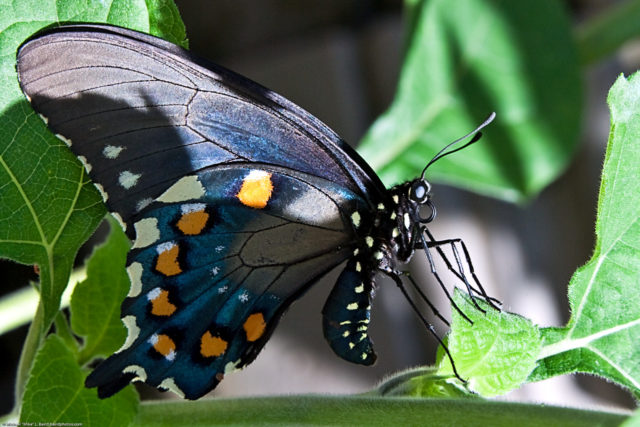
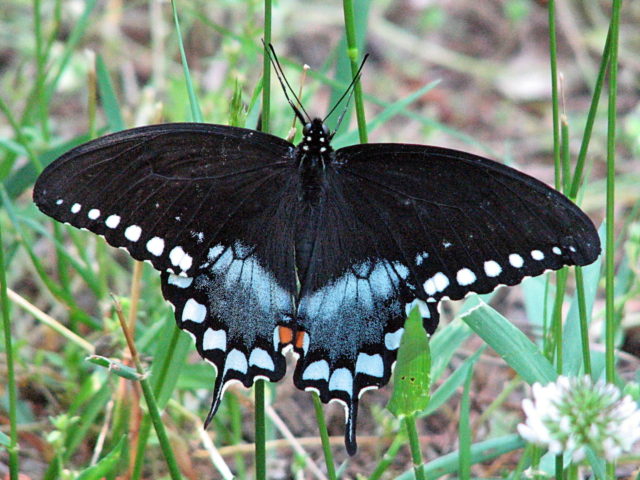
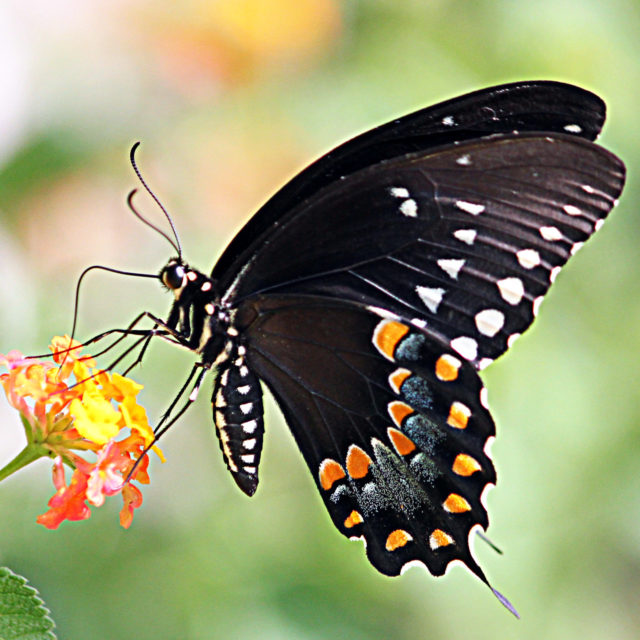
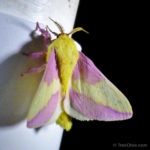
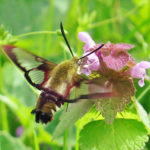
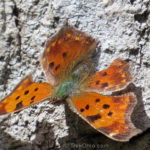
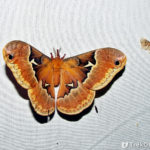
Hi, Deb – your description s helped me to identify a “dark morph” visitor. I also noticed that you could still see the tiger markings on the wings, since the sun was shining thru them at a low angle.
We have had a plethora of butterflies this summer and I just finished a painting of one of the black ones we have flying around. I thought it was a Spicebush until I saw that the body didn’t appear to have any white spots. However, there’s a white spot on it’s head so now I’m not sure what it is!
Thanks for your in-depth discussion on these beautiful creatures and thanks for admitting to being as confused by them as I am!!!!
On 07-01-15 there were about 6 of these butterflies on my cone flowers – they are predominantly black – the front 1/2 of the wings have a thin broken white pattern on the outside edge; in from the outside edge is a row of 5 white spots of varying shape; then there is a larger white spot that goes to the inside edge of the wing; these white markings are all in the front 1/3 of the wing; below the white markings is an orange band across the upper wing; this orange band is repeated on the back margin of the tail; together these 2 orange bands make an oval shape interrupted by the mid division of the wings and the head. If this description is not good enough, someone send me an email address where I can send you a photo image.
Happy summer.
Reggie Rose
Grove City, OH
My grandchildren and I saw this most beautiful butterfly around my flowers on the deck of my house. It stayed around all morning and was not afraid of us andjustflew around our heads. The boys were convinced that it was my mom from heaven to come down to say hello, since we had never seen one like that around here before. I looked it up and found out that it was a female eastern tiger swallowtail dark morph. Thank you for this description. It’s been two weeks and we haven’t seen it since.
I’m glad that my butterfly article was some help to you, Chris. It was very touching that this beautiful butterfly made the boys think about your mom.
Beautiful collection!
Deb: Don’t forget the Giant Swallowtail, which is also found in Ohio.
Ian Adams
Great pictures of all the butterflies. I guess I won’t try to remember the descriptions. It is too hard for my old brain ( 71 yrs. old ) so, I will have to take pictures in my garden and look them up .Thanks for the pics and descriptions. I really enjoyed them.
Thanks, Carol! I’m glad that you enjoyed the photos. I also try to take pictures and figure out what the species is later. But for a few species that I see all the time, eventually the species name sinks into my brain and stays. 🙂
Gorgeous captures! and for all this time I always thought all butterflies were female. They’re way too pretty to be male 🙂 silly me.
Another surprising one is the fact that there are male lady bugs. 😯
wow 🙂
What a wonderful post, GORGEOUS photos and great info!! And I can’t believe the female’s showier than the male… So odd, hahah! Love it!
Fantastic collection of photos from these beautiful butterflies. Your photos praise the beauty of them.
Great update! Made me smile :). I just love swallowtails!
Spicebush swallowtail is another mimic of the pipevine swallowtail if you want to confuse yourself further! 🙂
😯
Karen, thanks for pointing that out. I actually updated my post to include photos of the Spicebush swallowtail if you’d like to come back and take a look. Its caterpillar is darling!
Such BEAUTIFUL photos of butterflies!!! 🙂
Thanks, Carol! Based on feedback from Karen, I updated the post to include photos of another black butterfly, the Spicebush Swallowtail. If you have time, come back and take a look. Its caterpillar has the funniest, little face. 😀
Hi Deb – I just took a look at that caterpillar photo. That’s the cutest thing ever! Thanks for telling me it was there! 🙂